Over one billion euro has been invested in the wellness and spa industry in Bulgaria over the past more...
| Search | Hotels / Accommodation | Vacations | Tours & Trips | Rent A Car | Transport | Flights | Conferences | Press Centre | Yachting |
- Hotels & Accommodation in Balchik




- Mistral Hotel
- Regina Maria Spa Hotel



- Helios Hotel
- Lotos Hotel
- Marina City Complex
- Naslada Hotel
- Oasis resort village
- Selena Hotel
- Valeo Hotel


- Jasmine Villa
- Los Dos Gallos Hotel

- Bisser Hotel Complex



- Villa Lilly


- Villa Symphony
- Balchik Guide
- Early booking in Balchik
- All inclusive in Balchik
- Last minute in Balchik
- Hotels in Balchik
- Apartments in Balchik
- Villas in Balchik
- Rural houses in Balchik
- Vacations in Balchik
- Transport To Balchik
- Tours in Balchik
- Conferences in Balchik
- Articles on Balchik
- News From Balchik
- Balchik Palace
- The Botanic Garden
- Holidays in Bulgaria
- All inclusive
- Beach
- Birdwatching
- Golf
- Health
- History
- Hunting
- Monasteries/ Religious
- Mountain biking
- Prom
- Rural
- Ski
- Spa & Wellness
- Trekking
- Water sports
- Weekend breaks
- Wine
- Conference
- Children Holidays
- Yachting
- Events
- Type of accommodation
- Hotels
- Apartments
- Villas
- Rural houses
- Destinations
- Aheloy
- Ahtopol
- Albena
- Apriltsi
- Arbanassi
- Asparuhovo
- Assenovgrad
- Bachkovo Monastery
- Balchik
- Bankya
- Bansko
- Banya (Karlovo)
- Banya (Razlog)
- Batak
- Beklemeto
- Belchin Bani
- Beli Iskar
- Belogradchik
- Berkovitsa
- Blagoevgrad
- Bodrost
- Bojichen
- Borovets
- Botevgrad
- Bourgas
- Bozhentsi
- Bratsigovo
- Brestovitsa
- Buzludja
- Byala
- Chepelare
- Cherepish Monastery
- Chernomorets
- Chiflik
- Devin
- Dimitrovgrad
- Dobarsko
- Dobrich
- Dobrinishte
- Dolna Banya
- Dospat
- Dryanovo
- Dupnitsa
- Dyuni
- Elena
- Elenite
- Elhovo
- Gabrovo
- Gela
- Golden Sands
- Gorna Oryahovitsa
- Gotse Delchev
- Govedartsi
- Grand Hotel Varna
- Harmanli
- Haskovo
- Haskovo Mineral Baths
- Hissarya
- Ivaylovgrad
- Kalofer
- Kamchia
- Kamen Bryag
- Kardjali
- Karlovo
- Kavarna
- Kazanlak
- Kiten
- Kom
- Koprivshtitsa
- Kosharitsa
- Kostenets
- Kostenkovtsi
- Kotel
- Kovatchevitsa
- Kranevo
- Kresna
- Kulinoto
- Kyustendil
- Lom
- Lovech
- Lozenets
- Lukovit
- Lyaskovets
- Madara
- Malko Tarnovo
- Malyovitsa
- Melnik
- Mezdra
- Momchilovtsi
- Montana
- Narechen Baths
- Near Golden Sands
- Nessebar
- Obzor
- Ognyanovo
- Osogovo
- Pamporovo
- Panagyurishte
- Panichishte
- Parshevitsa
- Pavel Banya
- Pavlikeni
- Pazardjik
- Pernik
- Petrich
- Pirdop
- Pleven
- Pliska
- Plovdiv
- Pomorie
- Pravets
- Preslav
- Primorsko
- Ravda
- Razgrad
- Razlog
- Ribaritsa
- Rila Monastery
- Riviera
- Rousse
- Rusalka
- Samokov
- Sandanski
- Sapareva Banya
- Semkovo
- Sevlievo
- Shabla
- Shipka
- Shipkovo
- Shiroka Laka
- Shkorpilovtsi
- Shoumen
- Silistra
- Sinemorets
- Sliven
- Smolyan
- Sofia
- Sopot
- Sozopol
- Srebarna
- St. Constantine & Elena
- Stara Zagora
- Starozagorski Baths
- Sunny Beach
- Sunny Day
- Sveti Vlas
- Svilengrad
- Svishtov
- Targovishte
- Teteven
- Tran
- Trigrad
- Troyan
- Tryavna
- Tsarevo
- Tsigov Chark
- Uzana
- Varna
- Varshets
- Veliko Tarnovo
- Velingrad
- Vidin
- Vitosha
- Voneshta Voda
- Vratsa
- Vratsata Gorge
- Yagoda
- Yakoruda
- Yambol
- Zlatitsa
- Zlatograd
- Bulgaria Guide
- General information
- Bulgarian Monasteries
- SPA Bulgaria
- The Black sea
- History
- Geography
- Maps
- Weather
- Airports in Bulgaria
- Webcams
- Forums
- Mountains in Bulgaria
- The Balkan Mountain Range
- Rila Mountain
- Pirin Mountain
- The Rodope Mountain
- Vitosha Mountain
- Travel Arrangements
- Visit Bulgaria
- Visa Requierments
- Choose Destination
- Flights to Bulgaria
- Transport in Bulgaria
- Advice
- Currency
- Official Holidays
Subscribe to newsletters to receive our hottest offers:
| Home > Dobrich > Balchik > Press releases archive |
The Palace of the Romanian Queen
Georgie Georgiev
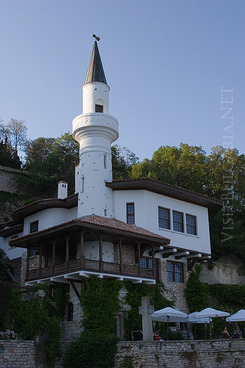
And there on coast deserted and alone
Caressed by eternal waters, but forever thrown
An ancient and nostalgic castle guards the shore
Castle - ominously wailing with its voiceless moan
There gardens shyly whisper timid dreams
While the poisonous dew softly trembles in its grief
And the dead water of the fountain seems
To be drowning shadow trees and vague sun beams.
Walls and vaults are dying tranquilly in age
While moss spreads with nails in columns’ range
No hour revealing happiness of sunny ray
No silver horn announcing gala day.
Only now and then a feeble whiff like breath
Awakes in sudden startled moan, so sad
That the dark pity of the virgin glory never shown
Reminds of some widowed and forgotten throne …
“The legend of the dissolute queen”, Dimcho Debelyanov
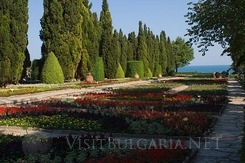 I don’t know whether the “Palace” in Blachik inspired the great Bulgarian Poet, Dimcho Debelyanov, to write this great poem, but when I visited the architecture monument, the first thing that made up my mind were those rhymes.
I don’t know whether the “Palace” in Blachik inspired the great Bulgarian Poet, Dimcho Debelyanov, to write this great poem, but when I visited the architecture monument, the first thing that made up my mind were those rhymes.
Do not let my association mislead you. Today “The palace” in Blachik is not deserted, crumbled castle, but a dazzling white, beautiful memory of the past, right on the sea shore, surrounded by an incredible botanic garden – the second important in Europe after the one in Monaco. But the history of the palace and the garden, as well as that of their creator, Queen Maria, make me remember “the legend” by Debelyanov and make up my own stories and legends. And the complex, which is called “Tenha Yuva” – “The Quiet Nook”, provides great prerequisites for that.
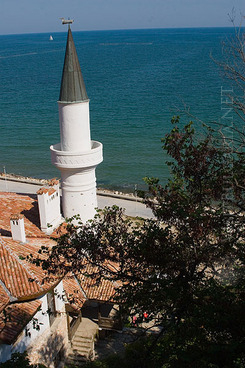 “The Palace” in Balchik is built by the Romanian Queen Maria in 1937. In fact the construction took more than 11 years. In 1924 queen Maria came in Balchik and was enchanted by the beauty of this site. During that time the town and all of the South Dobrudzha were part of Romania. Queen Maria is Scottish and her marriage with Ferdinand Romanian was due to political reasons. The life in the Romanian court, together with the constant unfaithfulness of her husband, took badly on her and she decided to transform the fairy bay in her own shelter. She ordered all land plots and deserted mills to be bought up and thus was marked the start of the construction works of the residence. The famous Italian architects Agustino and Amerigo undertook the hard task to sculpture the exquisite buildings, and the park complex was entrusted to the great florist Jules Janine. Several years later, “the Palace” was raised right on the sea shore. Numerous cosy individual villas emerged in the park complex, together with the main castle, in the park complex, to allow the inhibitors rest undisturbed, so the residents and the guests of the residence were able to relax in their chambers. According to several scientists, the parks and architecture of the “Palace” have a strong religious significance and the idea of the queen was to create a copy of the God’s lands. She spent part of her life in Egypt, where she accepted the Bahay religion. The study preaches equal rights between religions, sex and race, that is why the complex combines numerous cultural and religious influences. Here are numerous Christian and Muslim sacred buildings, and the columns, fountains and bridges, florid with oriental, Thracian, Roman and Christian symbols. Thus, as if like the whole world is gathered in this small, picturesque piece of land, close by the sea.
“The Palace” in Balchik is built by the Romanian Queen Maria in 1937. In fact the construction took more than 11 years. In 1924 queen Maria came in Balchik and was enchanted by the beauty of this site. During that time the town and all of the South Dobrudzha were part of Romania. Queen Maria is Scottish and her marriage with Ferdinand Romanian was due to political reasons. The life in the Romanian court, together with the constant unfaithfulness of her husband, took badly on her and she decided to transform the fairy bay in her own shelter. She ordered all land plots and deserted mills to be bought up and thus was marked the start of the construction works of the residence. The famous Italian architects Agustino and Amerigo undertook the hard task to sculpture the exquisite buildings, and the park complex was entrusted to the great florist Jules Janine. Several years later, “the Palace” was raised right on the sea shore. Numerous cosy individual villas emerged in the park complex, together with the main castle, in the park complex, to allow the inhibitors rest undisturbed, so the residents and the guests of the residence were able to relax in their chambers. According to several scientists, the parks and architecture of the “Palace” have a strong religious significance and the idea of the queen was to create a copy of the God’s lands. She spent part of her life in Egypt, where she accepted the Bahay religion. The study preaches equal rights between religions, sex and race, that is why the complex combines numerous cultural and religious influences. Here are numerous Christian and Muslim sacred buildings, and the columns, fountains and bridges, florid with oriental, Thracian, Roman and Christian symbols. Thus, as if like the whole world is gathered in this small, picturesque piece of land, close by the sea.
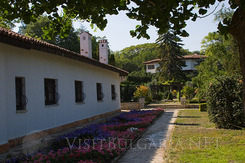 The cultural-historical value of the architectural complex is no doubt of huge significance. It is of a major significance and the unique flora diversity gathered in the garden and the way, the plants are arranged. But let leave this problem to the attention of historians, architects and botanists. For me “the Palace” is a combination of divine beauty, incredible atmosphere and a poetic sense of mystic. Each plant, hung, bridge, arch or vault suggests that this site was created by people of art for the people of art. Here Queen Maria held splendid receptions that gathered selected people from the European aristocracy. Regular guests were mainly poets, artists and musicians, and the Queen herself wrote poems under the pseudonym Carmen Sylva.
The cultural-historical value of the architectural complex is no doubt of huge significance. It is of a major significance and the unique flora diversity gathered in the garden and the way, the plants are arranged. But let leave this problem to the attention of historians, architects and botanists. For me “the Palace” is a combination of divine beauty, incredible atmosphere and a poetic sense of mystic. Each plant, hung, bridge, arch or vault suggests that this site was created by people of art for the people of art. Here Queen Maria held splendid receptions that gathered selected people from the European aristocracy. Regular guests were mainly poets, artists and musicians, and the Queen herself wrote poems under the pseudonym Carmen Sylva.
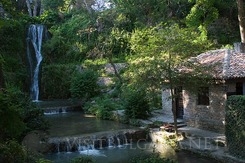 Probably not just one or two love meetings were held under the shadows of the wide park, which served as an inspiration of numerous works. The love life of the Queen, also gives reasons for the birth of national legends. According to some, Prince Cyril, a brother of the Bulgarian ruler from the time Boris III, was crazy in love with the Queen, who on her side gave her heart to a rich Turkish tradesman, who saved her daughter Uliana from drowning. The truth for the love affairs of the residential of the palace will remain forever hidden between the brunches of the threes in the park, and also and many other events in the life in the residence. For example, that one of the favorite sites of Queen Maria was the Rosarium, where she offered her guests opium, and later hidden behind the glass windows, she listened at their words, under the influence of the opiate. And during that time no one dared to say what’s on his mind.
Probably not just one or two love meetings were held under the shadows of the wide park, which served as an inspiration of numerous works. The love life of the Queen, also gives reasons for the birth of national legends. According to some, Prince Cyril, a brother of the Bulgarian ruler from the time Boris III, was crazy in love with the Queen, who on her side gave her heart to a rich Turkish tradesman, who saved her daughter Uliana from drowning. The truth for the love affairs of the residential of the palace will remain forever hidden between the brunches of the threes in the park, and also and many other events in the life in the residence. For example, that one of the favorite sites of Queen Maria was the Rosarium, where she offered her guests opium, and later hidden behind the glass windows, she listened at their words, under the influence of the opiate. And during that time no one dared to say what’s on his mind.
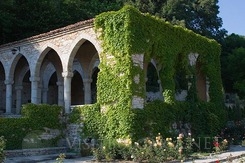 To be honest the last legend scares me a little and reminds me of the dark times of political conspiracy, treacheries and fear. I want to believe that “The Quiet Nook” was a shelter for different opinions and new ideas. That the Shakespeare’s “Summer Night's Dream” became true in “Tenha Yuva” and people – poets, artists and musicians, intoxicated by the wine in the Queen’s caller, embarked in games and entertainments, common for the gods, nymphs and the forest elfs. That in the Palace, they found quay for arts and never lasting strive for beauty and perfection. And if today you visit the residence, pass through the Venetian bridges, sit under one of the arch next to a plant, whose roots passed thousand of kilometres, to be sow here, if you concentrate on some of the exquisite statues and listen to the song of the birds and in the babble of the waterfalls, you will find out for sure that it was just like that.
To be honest the last legend scares me a little and reminds me of the dark times of political conspiracy, treacheries and fear. I want to believe that “The Quiet Nook” was a shelter for different opinions and new ideas. That the Shakespeare’s “Summer Night's Dream” became true in “Tenha Yuva” and people – poets, artists and musicians, intoxicated by the wine in the Queen’s caller, embarked in games and entertainments, common for the gods, nymphs and the forest elfs. That in the Palace, they found quay for arts and never lasting strive for beauty and perfection. And if today you visit the residence, pass through the Venetian bridges, sit under one of the arch next to a plant, whose roots passed thousand of kilometres, to be sow here, if you concentrate on some of the exquisite statues and listen to the song of the birds and in the babble of the waterfalls, you will find out for sure that it was just like that.
 One of the last legends puts an end of the life of Queen Maria and the bohemian life in the “Palace”. It says, that in a tragic evening the sons of the queen, Mihai and Nikoli argued for an young courtesan girl. During the quarrel they took out pistols. Their mother rushed to part them and Mihai instinctively shoot her deadly. In 1941 when Dobrudza again became Bulgarian territory, the young princes came to Balchik with an armada of ships and took away the remains of the queen in Romania. But the spirit of Maria Rumanian still haunts the complex, to protect it and remind all visitors for the passed glory of its widowed stone throne, from where she observed the sunset over the sea.
One of the last legends puts an end of the life of Queen Maria and the bohemian life in the “Palace”. It says, that in a tragic evening the sons of the queen, Mihai and Nikoli argued for an young courtesan girl. During the quarrel they took out pistols. Their mother rushed to part them and Mihai instinctively shoot her deadly. In 1941 when Dobrudza again became Bulgarian territory, the young princes came to Balchik with an armada of ships and took away the remains of the queen in Romania. But the spirit of Maria Rumanian still haunts the complex, to protect it and remind all visitors for the passed glory of its widowed stone throne, from where she observed the sunset over the sea.




























